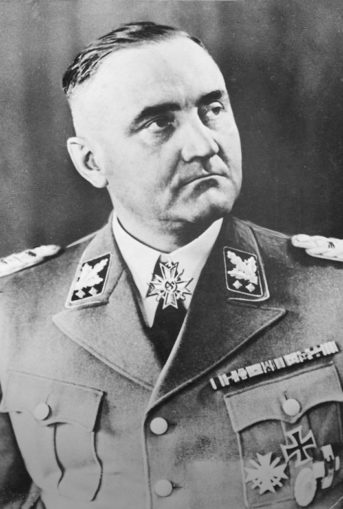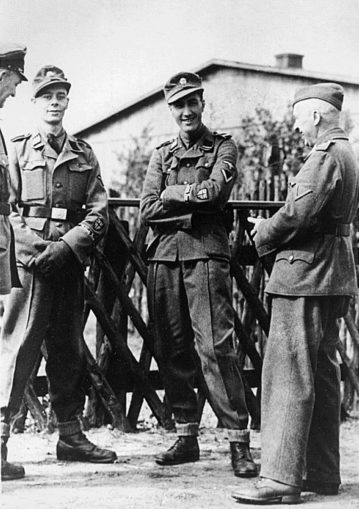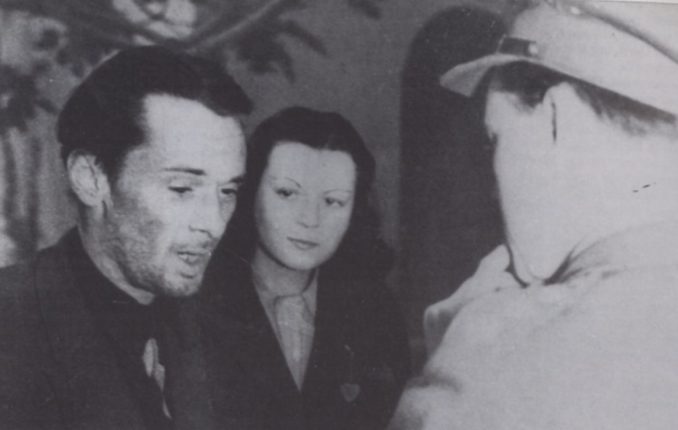
Bundesarchiv, Bild 183-S73321 / CC-BY-SA 3.0, CC BY-SA 3.0 DE, via Wikimedia Commons
“For every foreign-born soldier who dies, no German mother weeps” – Gottlob Berger
The Waffen SS was the military wing of the Nazi party, although it is important to note that membership of the NSDAP was not a requirement for enlistment in the SS nor was it obligatory afterwards. New recruits did have to meet to meet high physical standards, have no criminal record and be able to prove an unblemished ‘Aryan Ancestry’ for three generations. At one point even having had a single tooth filled would disbar a man from joining the elite SS Leibstandarte regiment.
As the war progressed and casualties mounted the SS was forced to cast its net progressively wider. First of all the newly occupied Western European and Scandinavian countries were trawled for recruits, and Nordic, French, Dutch and Belgian SS formations sprang up in short order. But by the end of World War Two the SS had been forced to accept men from racial groups which could by no means be described as Aryan. Serbs, Bulgarians, and Muslim Croats and Albanians donned the SS uniform and Heinrich Himmler’s vision of an army of blue eyed, blond haired automata who would sweep Bolshevism into the sea was looking a bit threadbare.
The man who convinced Himmler to embrace diversity and Multiculturalism, and who was tasked with overseeing the recruitment and enlargement of the SS fighting formations, was SS-Obergruppenführer Gottlob Berger. Berger survived the war, received a custodial sentence at Nuremberg which was somewhat reduced on appeal, and was back on the streets by the late fifties. He became politically active again, and was a firm supporter of the nascent European Union. He argued passionately for the necessity of a pan-European military force, and held up the multi-racial SS as an example which the chaps in Brussels could do worse than to emulate. Berger died in 1975, if not a major figure in German political circles then at least a moderately well respected one. And on that interesting little historical snippet, let us proceed to the meat of this article.
i) The Britische Friekorps

Waffen SS, Second World War, Public domain, via Wikimedia Commons
The idea to recruit a unit of British POWs was the brainchild of John Amery, Eton-educated son of the British Secretary of State for India, Leo Amery. After a series of failed business ventures led to him being declared bankrupt, John Amery moved to France and fell under the spell of the French Fascist leader, Jacques Doriot. Amery was still resident in France when the Nazis invaded. He made himself agreeable to the Germans and was soon invited to meet Hitler in Berlin, where he became a regular broadcaster on the Nazi English language radio station. The Germans are terrible snobs.
In 1943, Amery approached the authorities with a plan to tour the POW camps trawling for British anti-Bolshevist sympathisers willing to fight on the Eastern Front and was given the green light. Amery handed out propaganda leaflets, and invited any interested parties to spend a couple of weeks at a ‘holiday camp’ in Genshegen near Berlin. Here, as well as enjoying a more relaxed routine, prospective candidates would be vetted for suitability and commitment.
It is estimated that around 350 POWs eventually accepted the invitation to go to Genshagen Camp. Some were ordered to attend by their officers to gather intelligence, many just fancied a fortnight’s skive but there was a hardcore of ex-Mosleyite Blackshirts and anti-Bolshevists who were prepared to go the distance and who joined the fledgling Legion of St. George, as the unit was at first known. At this point Amery left Germany to go and work for Mussolini’s rump state Salo Republic, and fades out of the story.
ii) Formation
On the 1st January 1944, the unit was officially commissioned as an SS Infantry Korps and was given the title Britische Freikorps (The British Free Corps) . There were 58 members, and a small staff of German NCOs and officers. They wore standard SS uniforms but with a national shield bearing the Union Jack and a cuff band inscribed ‘Britische Freikorps’ on the left arm, and instead of the SS runes on the right collar patch they had three heraldic lions.
All the ex-POWs had enlisted under pseudonyms, but it is known that amongst their number were a Canadian who had been captured in the St Nazaire Raid in 1942, a merchant seaman who had survived his ship being torpedoed on the Murmansk run, and a New Zealander who had been taken prisoner in Greece. There were also three South Africans.
They spent 1944 in training and recruiting new members. The Germans, ever a chirpy and optimistic bunch, had had 800 Britische Freikorps uniforms made up in expectation of a flood of recruits. The recruiters visited POW camps and told the inmates that there were already two British SS regiments in existence, and that the Freikorps was “a thoroughly volunteer unit, conceived and created by British subjects from all parts of the Empire who have taken up arms and pledged their lives in the common European struggle against Soviet Russia”. Despite this, the POWs were far better informed as to the course of the war than the Freikorps renegades and as the year progressed the trickle of volunteers diminished.
On a side issue, if you collect Militaria you may occasionally come across an item purporting to be from the Freikorps: the National Shield, cuff title or collar patch. These are inevitably fakes. I am not aware of a single genuine Britische Friekorps item in existence in either a museum or a private collection. Similarly the Fez hats worn by the Albanian 21st SS Division ‘Skanderbeg’. Items described as such are usually just an appropriately coloured Fez, sometimes of approximately the right vintage, but with a reproduction SS skull and crossbones cap badge stuck on the front. Caveat, as always, emptor.
iii) Active Service
By early 1945 the Eastern Front was on the River Oder line in Poland, and getting closer to Berlin all the time. The British Free Corps was sent to the sector and attached to the third company of the armoured reconnaissance battalion of SS Division Nordland, which was largely composed of Scandinavians and which itself was part of III SS Panzer Korps under General Felix Steiner.
On 23 March the 3rd Company moved to the west bank of the Oder and began digging in. Before their entrenchments were complete, 3rd Company was partially overrun by an advance element of the Soviet Army which blundered into their positions by accident. The men quickly gathered their wits, and launched a series of counter attacks which drove off the enemy. The men of the Britische Freikorps acquitted themselves well.
On 16 April, the Britische Freikorps was reassigned to Steiner’s HQ Transport Company. By now the Battle for Berlin was in full swing and Steiner was placed in command of Kampfgruppe Steiner, a formation which existed largely only on paper. On 21 April, Hitler ordered Steiner to break the Soviet encirclement of Berlin by making a pincer movement to the east.
This would have involved a suicidal attack, as the Russian forces outnumbered Steiner’s by ten to one. Steiner refused to squander his mens’ lives and instead ordered his Kampfgruppe, and the Britische Freikorps, to head westwards into Anglo-American captivity. Hitler’s towering outburst of rage at the news that Steiner was not coming to his rescue was later made famous in a scene in the film ‘Downfall’, which has spawned a thousand subtitled parody video grabs.
iv) Aftermath

Public Domain
[PIC3 Here] – John Amery and his girlfriend upon their arrest in Milan in 1945. The officer with his back to the camera is Alan Whicker
The men of the Britische Freikorps straggled into captivity, and the last two were in the bag by 2 May. In total, eighteen men survived to stand trial. All were charged with treason. Two were given the death penalty, but their sentences were commuted, and all served lengthy periods of imprisonment.
Upon release they slipped quietly back into civilian life. Some emigrated: one to Germany and one to Japan. One studied for a chemistry degree whilst in prison, and afterwards became a pharmacist in Lancashire. Another ran a pub in a little village that stands on the old Roman road halfway between Ripon and York. None of them wanted to talk much about their past. The last surviving member of the Britische Freikorps died in 2001.
John Amery had spent the final months of the war in northern Italy, and was captured by Italian partisans. He and his girlfriend were held in a hotel in Milan until he could be handed over to the British Authorities. The British officer who took him into custody was Captain Alan Whicker, who later went on to be a famous TV journalist. Amery was charged with treason.
At a preliminary hearing Amery argued that he had never attacked Britain and that he was an anti-Communist, not a Nazi. His Counsel, Gerald Osbourne Slade KC, argued that Amery was mentally ill and Amery’s father agreed. On the first day of the trial, however, Amery pleaded guilty to all charges and was sentenced to death. The trial lasted eight minutes from start to finish. Amery was hanged in Wandsworth Prison on 19th December 1945.
His body lay buried in the prison cemetery until 1996, when his brother Julian successfully petitioned to have his remains disinterred and cremated. His ashes were scattered in France.
After his son’s execution, Leo Amery approached the editors of Who’s Who to have his entry amended to read “one son”. But after his own death, this short verse was found as an entry in Leo Amery’s diary:
At end of wayward days he found a cause –
‘Twas not his Country’s – Only time can tell
If that defiance of our ancient laws
Was treason or foreknowledge. He sleeps well.
This article was first published in Feb 2019.
© bobo 2021
The Goodnight Vienna Audio file
Audio Player



